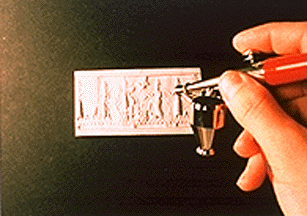 |
3D Model Making
(excerpted from HMP 6 - Chapter 2)
 |
A model maker from Laser Holography Workshop adds detail to a relief model before it is recorded in a hologram.
Although some three-dimensional holographic images are being produced using compilations of a series of digitized graphics, most holograms are still created by recording the laser light reflected off of a (3D) physical object, such as a highly-detailed miniature model or a specially-sculpted scene. Therefore, the process of creating a custom designed holographic image usually requires the use of an expert sculptor or model maker who can best translate a client’s ideas a into three-dimensional artwork appropriate for holographic reproduction.
To gain an basic understanding of the elements involved in producing a successful model for holograms, we consulted George Sivy, of Richmond Development Group. Sivy has been a holography model maker for eleven years. He worked for Polaroid during their first years in holography, making models utilized for custom and stock images (such as the popular "Brain/Skull" which appeared on the cover of the Holography MarketPlace’s Third Edition). In addition, he has collaborated on numerous commercial projects, ranging from embossed security holograms to photopolymer holograms designed for the giftware market.
Sivy is convinced that well-designed and well executed artwork is the basic element from which a successful hologram is created. Of the three components Sivy lists as necessary to the creation of a holographic image: the artist; the holographer; and the manufacturer; "…Quality work from all three is important. Artwork, however, is key, in that good, well-conceived and carefully executed artwork will carry mediocre holography and/or manufacturing. Even the very best holography and the highest quality manufacturing can’t make up for poorly-done artwork."
He has three basic suggestions for those who are working with model-makers to create a hologram that "works": plan in advance; remain in direct contact with the artist from start to finish; and be willing to pay for the artist’s time and expertise.
Communication
Since the client is often unfamiliar with the
technological processes that are used to create a hologram and
salespeople frequently gloss over the medium’s limitations,
the model maker often assumes the role of educator as well as
craftsperson. This requires that model makers be effective
communicators who can work with both conceptual and technical
issues. "A hologram, under the best of circumstances, is
still an interpretation of the client’s 2D artwork,"
states Sivy.
"Nine out of ten of these people do not know what to expect
in terms of time and other factors, which go into creating a
piece," he states. Because of this, he says, there can be
"communication gaps, misunderstandings, and deadlines which
are too tight...expectations should be more appropriately
formed."
Sivy advises that the client be brought into the loop even when art directors or ad agencies are involved. Ideally, the client, the client’s art director, the salesperson, the model maker, the holographer, the replicator, and the finisher will all agree on the various elements that will ensure a top quality result. All parties should agree on a realistic production schedule and should communicate regularly. Since the model maker is usually responsible for the first tangible output seen by the client, the credibility of the entire process is affected by the professionalism displayed by this participant...
More information regarding traditional model making for holography, as well as the latest computer assisted techniques is included in Chapter 2 - Artwork Origination of the Holography MarketPlace 6th Edition.
Total cost for HMP6
Delivered airmail to your door:
$30 (USA) (UPS ground)
$35 (Alaska, Hawaii, Canada, Mexico)
$45 (all other countries).
